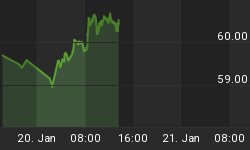Technical observations of Ross.Clark@ChartWorks.ca
Originally sent to subscribers on February 11, 2018
The rise in Treasury Bond yields that started following our signal in July 2016 has come in two waves. The first produced overbought readings into December 2016 and was followed by a drift lower through September. Since then they have moved higher, gaining momentum in the last five weeks as 10-Year yields reached 2.8%. This has produced overbought Exhaustion Alerts and Sequential 9 Sell Setups in the daily and weekly charts. Such 'Signs of Strength' coming out of a consolidation pattern are generally confirmation of a breakout. If minor corrections of one to four weeks hold above the breakout and the January low, we can look forward to sustained movement to the upside.


The TBF is an inverse ETF that provides the opportunity to participate in the short side of the 20+ Year Treasuries. The TBX is the short 7-10 Year Treasury. The SJB corresponds to the inverse of the High-Yield Index. There are also Ultra-Short versions of each of these.
The monthly data has an RSI(14) of 67. This matches the highs dating back to 1981. In the declining interest rate environment of the last three decades rates have peaked seven times with an RSI between 60 and 67. Note that the first month with a lower low in the yield became the catalyst for the next sustained move down.
However, in the two decades leading up to 1981 the strong momentum consistently pushed the RSI above 67. It reached 90 in 1966, 81 in 1969, 71 in 1974 and 82 in 1980. Minor corrections were followed by higher yields. The four important highs in yields did not occur until a bearish divergence was formed.
We'll monitor the current move with a close eye on progressively higher lows in the monthly chart.
The long bond price (inverse to yields) has now broken the bottom of the rising channel drawn from 1984. (We account for the anomaly in prices since February 27, 2015.)
December 2016 experienced three weekly Capitulation Alerts as prices tested the 100-month moving average. Note that the three previous Capitulation Alerts (1986, 1999 & 2006) saw prices retest the 100-month moving average six to thirteen months later, just as we experienced in October through December. January then staged a clear violation to the downside. Each close below the moving average since 1986 has resulted in an upside reversal in the following month.
A failure to turn higher by the end of February will be a complete change of the long-term character and imply that the major uptrend in interest rates is occurring.
Long Bond price (weekly from 1980)
Opinions in this report are solely those of the author. The information herein was obtained from various sources; however, we do not guarantee its accuracy or completeness. This research report is prepared for general circulation and is circulated for general information only. It does not have regard to the specific investment objectives, financial situation, and the needs regarding the appropriateness of investing in any securities or investment strategies discussed or recommended in this report and should understand that statements regarding future prospects may not be realized.
Investors should note that income from such securities, if any, may fluctuate and that each security's price or value may rise or fall. Accordingly, investors may receive back less than originally invested. Past performance is not necessarily a guide to future performance. Neither the information nor any opinion expressed constitutes an offer to buy or sell any securities or options or futures contracts. Foreign currency rates of exchange may adversely affect the value, price or income of any security or related investment mentioned in this report. In addition, investors in securities such as ADRs, whose values are influenced by the currency of the underlying security, effectively assume currency risk. Moreover, from time to time, members of the Institutional Advisors team may be long or short positions discussed in our publications.


















